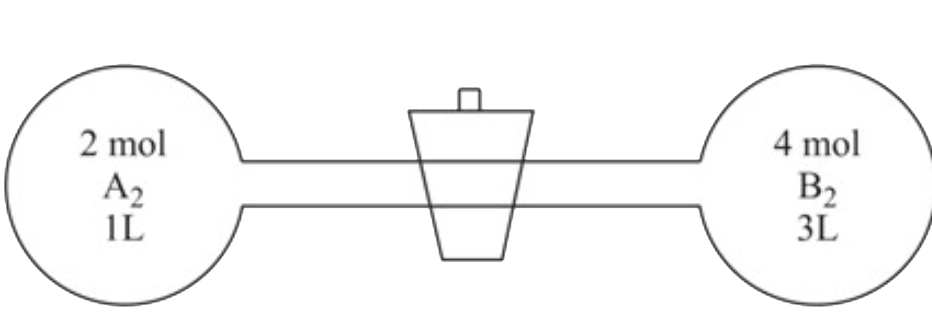10 moles of A2,15 moles of B2 and 5 moles of AB are placed in a 2 litre vessel and allowed the come to equilibrium. The final concentration of AB is 10.5 M, A2(g)+B2(g)⇔2AB(g)
Determine the value of equilibrium constant (KC) for the reaction.
25.3
31.5
36.3
40.5
The correct Answer is:B
To determine the equilibrium constant Kc for the reaction A2(g)+B2(g)⇌2AB(g), we will follow these steps:
Step 1: Calculate Initial Concentrations
We start with the initial moles of each substance:
- Moles of A2 = 10 moles
- Moles of B2 = 15 moles
- Moles of AB = 5 moles
Since the volume of the vessel is 2 liters, we can calculate the initial concentrations:
Initial concentration of A2=10 moles2 L=5 M
Initial concentration of B2=15 moles2 L=7.5 M
Initial concentration of AB=5 moles2 L=2.5 M
Step 2: Set Up the Change in Concentration
Let x be the amount of A2 and B2 that reacts at equilibrium. The changes in concentrations will be:
- For A2: 5−x
- For B2: 7.5−x
- For AB: 2.5+2x
Step 3: Use the Final Concentration of AB
We know the final concentration of AB is 10.5 M. Therefore:
2.5+2x=10.5
Solving for x:
2x=10.5−2.5=8⇒x=4
Step 4: Calculate Equilibrium Concentrations
Now we can calculate the equilibrium concentrations:
- Concentration of A2:
Equilibrium concentration of A2=5−x=5−4=1 M
- Concentration of B2:
Equilibrium concentration of B2=7.5−x=7.5−4=3.5 M
- Concentration of AB:
Equilibrium concentration of AB=10.5 M
Step 5: Write the Expression for Kc
The expression for the equilibrium constant Kc for the reaction is given by:
Kc=(AB)2(A2)(B2)
Substituting the equilibrium concentrations:
Kc=(10.5)2(1)(3.5)
Step 6: Calculate Kc
Now we calculate Kc:
Kc=110.253.5=31.5
Final Answer
Thus, the equilibrium constant Kc for the reaction is:
31.5
---
We start with the initial moles of each substance:
- Moles of A2 = 10 moles
- Moles of B2 = 15 moles
- Moles of AB = 5 moles
Initial concentration of A2=10 moles2 L=5 M
Initial concentration of B2=15 moles2 L=7.5 M
Initial concentration of AB=5 moles2 L=2.5 M
Let x be the amount of A2 and B2 that reacts at equilibrium. The changes in concentrations will be:
- For A2: 5−x
- For B2: 7.5−x
- For AB: 2.5+2x
We know the final concentration of AB is 10.5 M. Therefore:
2.5+2x=10.5
Solving for x:
2x=10.5−2.5=8⇒x=4
Now we can calculate the equilibrium concentrations:
- Concentration of A2:
Equilibrium concentration of A2=5−x=5−4=1 M
- Concentration of B2:
Equilibrium concentration of B2=7.5−x=7.5−4=3.5 M
- Concentration of AB:
Equilibrium concentration of AB=10.5 M
The expression for the equilibrium constant Kc for the reaction is given by:
Kc=(AB)2(A2)(B2)
Substituting the equilibrium concentrations:
Kc=(10.5)2(1)(3.5)
Now we calculate Kc:
Kc=110.253.5=31.5
Thus, the equilibrium constant Kc for the reaction is:
31.5
Topper's Solved these Questions
Similar Questions
Calculate Kc for the reaction: A(g)+B(g)⇔2C(g) , if 1 mole of A, 1.4 moles of B and 0.50 mole of C are placed in a one-litre vessel and allowed to reach equilibrium. The equilibrium concentration of C is 0.75 mole per litre.
View SolutionThe factor which changes equilibrium constant of the reaction
A2(g)+B2(g)→2AB(g) is
View Solution
Knowledge Check
In the reaction X(g)+Y(g)⇔2Z(g),2 mole of X,1 mole of Y and 1 mole of Z are placed in a 10 litre vessel and allowed to reach equilibrium .If final concentration of Z is 0.2 M , then Kcfor the given reaction is :
A1.60B803C163Dnone of these3 moles of A and 4 moles of B are mixed together and allowed to come into equilibrium according to the following reaction.
3A(g)+4B(g)→2C(g)+3D(g)
When equilibrium is reached, there is 1 mole of C. The equilibrium constant of the reaction isA(14)4B(13)3C(12)4D11 mole of 'A' 1.5 mole of 'B' and 2 mole of 'C' are taken in a vessel of volume one litre. At equilibrium concentration of C is 0.5 mole /L .Equilibrium constant for the reaction , A(g)+B(g)⇔C(g) is
A0.66B0.066C66D6.6
Determinre the value of equilibrium constant (KC) for the reaction
A2(g)+B2(g)⇔2AB(g)
if 10 moles of A2 ,15 moles ofB2 and 5 moles of AB are placed in a 2 litre vessel and allowed to come to equilibrium . The final concentration of AB is 7.5 M:
View Solution3 moles of A and 4 moles of B are mixed together and allowed to come into equilibrium according to the following reaction.
3A(g)+4B(g)→2C(g)+3D(g)
When equilibrium is reached, there is 1 mole of C. The equilibrium constant of the reaction is
View SolutionWhen 3.00 mole of A and 1.00 mole of B are mixed in a 1,00 litre vessel , the following reaction takes place
A(g)+B(g)⇔2C(g)
the equilibrium mixture contains 0.5 mole of C. What is the value of equilibrium constant for the reaction ?
View SolutionThe equilibrium constant for the reaction
A2(g)+B2(g)⇔2AB(g)
is 20 at 500K. The equilibrium constant for the reaction 2AB(g)⇔A2(g)+B2(g) would be
View Solution
When A2andB2 are allowed to react, the equilibrium constant of the reaction at 27∘C is found (KC=4).A2(g)+B2(g)⇔2AB(g)
What will be the equilibrium concentration of AB?
View Solution
